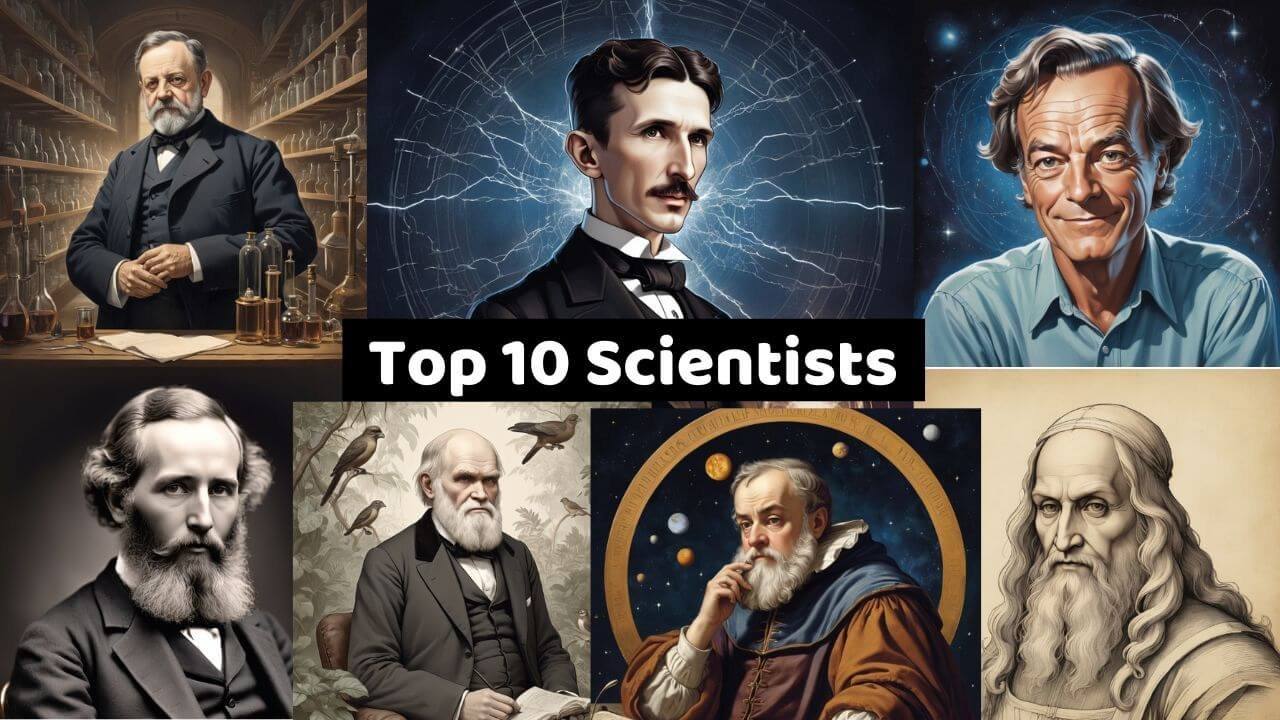Throughout history, some amazing scientists have changed the way we understand the world. These smart and curious people made important discoveries that help us every day. From figuring out why apples fall to the ground to discovering how the stars move in the sky, their stories are exciting and inspiring.
10 Influential Scientists
Let’s explore the lives of the top 10 most influential scientists of all time, who used their big ideas and hard work to make the world a better place and showed us that science can be fun and full of surprises!
- Isaac Newton (1643-1727)
- Albert Einstein (1879-1955)
- Galileo Galilei (1564-1642)
- Charles Darwin (1809-1882)
- Marie Curie (1867-1934)
- Nikola Tesla (1856-1943)
- James Clerk Maxwell (1831-1879)
- Louis Pasteur (1822-1895)
- Richard Feynman (1918-1988)
- Leonardo da Vinci (1452-1519)
Isaac Newton (1643-1727)

Newton’s discoveries helped us understand how objects move and stay in orbit, like the moon around the Earth.
One day, Isaac Newton was sitting under an apple tree when an apple fell on his head. This made him think about why things always fall down. He discovered the law of gravity, which explains why things fall to the ground.
Albert Einstein (1879-1955)

When Albert Einstein was a child, his father gave him a compass. Albert was fascinated by how the needle always pointed north, which sparked his curiosity about how the world works. Later, he developed the theory of relativity, which changed our understanding of space and time.
Einstein’s work helps us understand the universe, from the smallest particles to the largest galaxies.
Galileo Galilei (1564-1642)

Galileo loved looking at the stars through his telescope. He discovered that the moon has mountains and that Jupiter has moons of its own. These observations helped him prove that the Earth moves around the Sun.
Galileo’s discoveries showed that we should always question and test what we think we know about the world.
Charles Darwin (1809-1882)

Charles Darwin went on a long voyage on a ship called the HMS Beagle. He visited the Galápagos Islands, where he observed different animals and plants. These observations helped him develop his theory of evolution by natural selection.
Darwin’s work taught us how all living things are connected and how they change over time to survive in their environments.
Marie Curie (1867-1934)

Marie Curie was very curious and loved science. She discovered two new elements, radium and polonium, and studied a mysterious thing called radioactivity. She even won two Nobel Prizes for her amazing work.
Marie Curie’s discoveries help doctors treat diseases like cancer and have opened new fields of science.
Nikola Tesla (1856-1943)

Nikola Tesla dreamed of creating inventions that would make life better for everyone. He invented the system of alternating current (AC) electricity, which is used to power homes and buildings today. He also had many ideas about wireless communication.
Tesla’s inventions are the backbone of our modern electrical systems and have paved the way for many technologies we use today.
James Clerk Maxwell (1831-1879)

James Clerk Maxwell loved solving puzzles and figuring out how things work. He discovered that electricity and magnetism are connected and created the famous Maxwell’s equations. These equations describe how electric and magnetic fields interact.
Maxwell’s work helps us understand and use electricity and magnetism in everyday devices like radios, TVs, and smartphones.
Louis Pasteur (1822-1895)

Louis Pasteur was curious about why people got sick. He discovered that tiny germs cause diseases. He developed a way to kill germs in milk, called pasteurization, and created vaccines to prevent diseases.
Pasteur’s discoveries keep our food safe and help prevent illnesses with vaccines.
Richard Feynman (1918-1988)

Richard Feynman loved playing with puzzles and learning how things work. He made important discoveries in quantum mechanics, a science that studies tiny particles. He also loved explaining complex science in simple ways.
Feynman’s work helps us understand the building blocks of the universe and has inspired many scientists with his playful approach to learning.
Leonardo da Vinci (1452-1519)

Leonardo’s work combines art and science, showing us that creativity and curiosity can lead to amazing discoveries.
Leonardo da Vinci was a brilliant artist and inventor. He drew detailed sketches of the human body and designed flying machines, tanks, and other inventions far ahead of his time.
Read Related Article:
- Transformative Technologies: 20 Innovations that Changed the World
- Understanding Gravity: Why Do Things Fall?
- The Basics of Newton’s Laws of Motion

